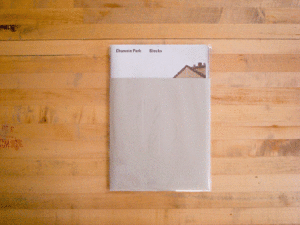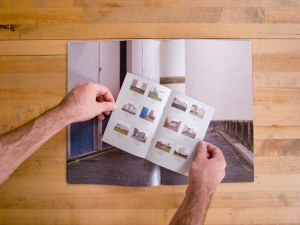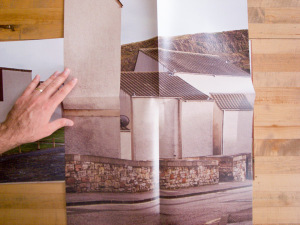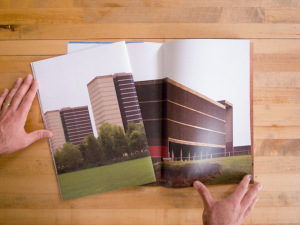Every time that I have gone to Korea I have been absolutely astounded by the pace and the sheer volume of hi-rise apartment construction. While most of this astonishment has been a general sense of enormity suggested by the breadth of this construction, over my last several visits I have been able to watch one particular development being built across from my mother in law’s apartment complex. What was once a small tangle of streets forming a neighborhood is now a construction site from which half a dozen towers are rising. (Alan, the post office from which we sent the DIY first issue letter is now gone and its postmark now rare, if not valuable.) This development sits directly between two existing developments and within spitting distance of at least three other new developments.
I feel ambivalence about this construction. If my mother in law’s apartment is anything to go by, the apartments in these buildings are spacious, comfortable and well appointed. Sales of the units seem quick; people seem eager to move into them; and prices are considerable. On the other hand, as an outsider steeped in Jane Jacobs, Lewis Mumford, Ebenezer Howard and (more recently) Paul Virilio I can’t help but be somewhat horrified by what appears at times wanton destruction of charming knotty neighborhoods and urban design that creates a mono-street-culture. Jacobs and Mumford in particular would be aghast at the lack of shops and street life (aside from the playgrounds that are situated in most of these developments). The old neighborhoods had a significantly greater mixture of shops, offices and residencies. The new developments have towers and some green between. Howard might be down but Lynch might have a few questions as to how to orient oneself.
And this brings me now to Park’s Blocks. This unbound tabloid size publication on heavy stock comprises formal photographs of apartment blocks in Scotland. Paging through the book, one finds it necessary to deconstruct the book in order to see the photographs. The “book” is more like a set of folded and nested posters. The photographs bump up against one another–blending and repulsing across the shifting gutter. Only by pulling the pages out one by one do the individual photographs reveal themselves.
Once maneuvering the physical book has been sorted, it becomes apparent that something is not right. Something feels wrong. The blocks are too block like. They appear toy-like, artificial. There are no windows on any of the buildings’ surfaces. All we get is smooth concrete, expanses of pebbled stone, and uninterrupted brick. What at first glance seems like a Becher-esque directness reveals a highly constructed and manipulated image. The photographer made these buildings as much as or more than he recorded them. The title brings to mind my nieces’ “building blocks.” They build cities entire and then knock them down to begin again. (Or forget them and move on to other tasks.)
Blocks presents a high-level image of the city. There is almost none of the nitty gritty day to day. There are no people in the photographs–either walking about or suggested. (On a last flip through, I did find one man, just turning around a corner.) Any trace of lives lived or personal histories tied to place are erased. The most we get of human traces are an uneven patch of paint, a few plants outside a door, a row of parked cars and an oil stain where a car was once parked. There is no litter on the streets. The lack of windows is an extension of this. We are forced to consider dispassionately the city as a built object. We cannot allow our vision to be clouded by the emotion of specific personal narratives. (Indeed, the skies are cloudless.)
Park’s previous project, intimate city, examined the rise of the apartment in Korean urban culture and compared it to existing housing stock in Seoul. (I know this only because of Hyeyoung Shin’s astute and useful essay** tucked into Blocks.) It seems a logical next step to seek out earlier urban development (the blocks in the photographs were constructed twenty, thirty, fifty years ago) and look for any questions that they might suggest regarding the future of the development taking place in Korea. This unfairly flattens Park’s intention. Park is broadly interested in the urban environment and how photography can describe and comment upon the residential urban environment. I hope his camera will carry him onward to other urban environments. I would love to see the photographs he might make in San Jose or Istanbul or even a reborn or struggling New England mill-town.
Blocks
Chanmin Park
Designed by Yeoun Joo Park
Publishing by IANNBOOKS
Printed in Seoul, South Korea
© 2012
IANNBOOKS
1428 gyeonghuigungeul achim 3-danji,
naesu-dong, jongno-gu, Seoul, 110-872, Korea
T +82 (0)2 734 3105
F +82 (0)2 734 3106
**A short side note regarding Shin’s essay: I have some quibbles with it; though I am nitpicking. The essay as a whole is a useful part of Blocks that gave helpful context to Park’s photographic oeuvre and a framework for understanding the work. Shin speaks convincingly in regards to the context of the photographs and what they are meant to describe. However, towards the end of the essay she writes about Park’s conceptual and technical processes as staking out a particularly contemporary Korean process. She writes that he
solidifies his identity as a photographer from Korea who lives in the 2000s. His characteristics are shown clearly by his activities before and after taking photographs. Before taking photographs, he does an in-depth research through the internet and with books. When he studied in Scotland, he was not familiar with the area. Instead of walking around the city endlessly like a flaneur in the 19C century [sic], he planned for detailed scenes in advance by using the internet maps and road view obtained from Google Earth, etc. and then began shooting. After shooting, he wrote down the numbers of the latitude and longitude on each picture as a subtitle. And, rather than entering the dark room [sic] to develop the photos with chemicals, he put the high-resolution data of the photos into the computer and make [sic] natural images by erasing the necessary parts in the photos with a digital technology before printing them out.
My disagreement with Shin’s contention is that could name a number of Korean and non-Korean photographers whose working methods would conflict with her contention. Among many serious photographers that I know, it is normal to research and to plan before shooting. Hell, for some photographers that research becomes the photography and becomes the point. My friend Cally Iden has used Google Maps, Google Earth and geo-tagging in her work. Within amateur photography there are many who geotag their photographs with GPS coordinates–my phone will do it for me, automatically. And working digitally isn’t Korean; it is contemporary. Park’s use of digital manipulation and digital metadata marks his photographic process as being of the 21st century (though it would be fair to say that there was plenty of both manipulation and “meta” data in photography from its inception).
On a more personal note, I took the subtext that there is greater intentional value in creating a premeditated photograph than in wandering as a flaneur seeking the found photograph to be off-putting. I myself am more of a wanderer seeking out the unexpected rather than a planner who creates a specific image in my mind beforehand. While my emotional response might be mixing my photographer and critic hats, even leaving my own work out of my response, many of the photographers whose work I enjoy and respect are very much of the seeking variety. Many of the Korean photographers that I have written about here are seekers.
I will hedge my response by saying that perhaps Shin is suggesting that it is the combination of these attributes of Park’s process are strong indicators that his work is that of a particularly Korean photographer. I still think that this is shaky ground, but at least I could point to other Korean photographers whose similar working methods might buttress Shin’s contention.




Pingback: New(ish) Reviews at Korean Photo Books « daily_up